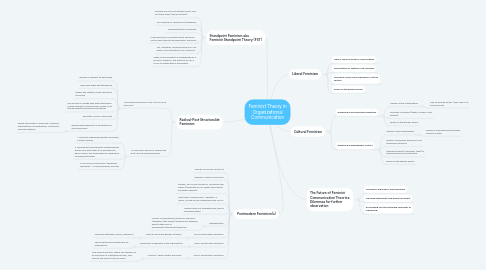
1. Standpoint Feminism aka Feminist Standpoint Theory (FST)
1.1. Women are not only different from men but each other (social location)
1.2. No essential or universalist sisterhood
1.3. Intersectionality is required
1.4. Is derived from: socialist/Marxist feminism, critical race theory psychoanalytic feminism
1.5. Yet, ultimately, research using FST can easily communication to an outcome
1.6. When communication is emphasized as a process, however, the potency of FST's focus on materiality is diminished.
2. Radical-Post Structuralist Feminism
2.1. Uses liberal feminism to say "na-na na-na boo-boo"
2.1.1. Gender is inherent to patriarchy
2.1.2. Masculine ways bad/repressive
2.1.3. Reject the systems, they cannot be reformed
2.1.4. Put women in charge who have developed a deep feminist consciousness to get rid of the dominant/masculinist institutions
2.1.5. Definitely not pro-femininity
2.1.6. Bureaucracy/hierarchy is an iteration of masculine ways
2.1.6.1. Ferree and Martin's 1995 book: Feminist organizations are egalitarian, collectivist, and participatory.
2.2. In org comm: hybrid of radical and post-structuralist feminisms
2.2.1. 1. Feminist organizing benefits everyone, not just women
2.2.2. 2. Recognition that feminist organizing has pitfalls and that aspects of bureaucracy have a place, but using feminist organizing as guiding principle
2.2.3. 3. Discourse community / gendered rationality - a communication process
3. Postmodern Feminism(s)
3.1. Gender is a social construct
3.2. Gender is made in discourse
3.3. Gender, as a social construct, contitutes the subject (opposite of FST where the subject contitutes gender)
3.4. But there is nothing else - gender is a given, so how do we understand and use it?
3.5. Gender does not operate alone, hence intersectionality
3.6. Intertextuality
3.6.1. Cannot conceptualize American feminism (whatever that means) without also thinking about other kind of womanhood/femininity/feminism.
3.7. Micro-postmodern feminism
3.7.1. "How do we enact gender at work?"
3.7.1.1. Individual attitudes, beliefs, behaviors
3.8. Meso-postmodern feminism
3.8.1. Production of gender by the organization
3.8.1.1. The work/discourse within/by an organization
3.9. Macro-postmodern feminism
3.9.1. Cultural / large system discourse
3.9.1.1. How does discourse, which can happen on an individual or interpersonal level, find itself at the macro/cultural level?
4. Liberal Feminism
4.1. Liberal feminist politics: Conservative
4.2. Reformation of systems, not rejection
4.3. Prejudice comes from individuals, not the system
4.4. Relies on the gender binary
5. Cultural Feminism
5.1. Gendered Communication Expertise
5.1.1. Gender in the origanization
5.1.1.1. Man vs woman binary / two "ways" to communicate
5.1.2. Feminine is feminist (white, middle-class women)
5.1.3. Relies on the gender binary
5.2. Gendered Organizational Culture
5.2.1. Gender of the organization
5.2.1.1. Gender is manufactured through communication
5.2.2. What is considered feminine is not necessarily feminist
5.2.3. Intersectionality (Crenshaw, 1989) is introduced but not explicated
5.2.4. Relies on the gender binary
